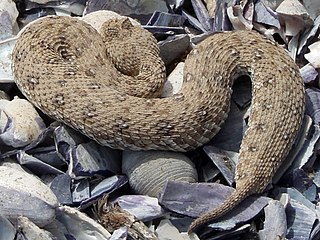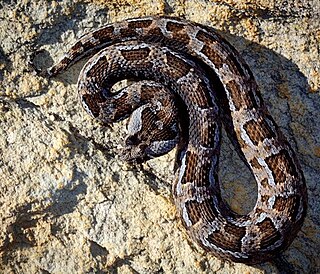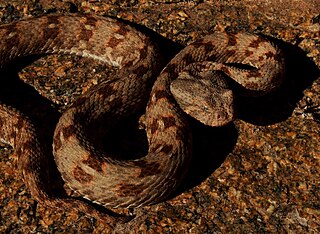
The torrent duck is a member of the duck, goose and swan family Anatidae. It is the only member of the genus Merganetta. It is placed in the shelduck subfamily Tadorninae after the "perching duck" assemblage to which it was formerly assigned was dissolved because it turned out to be paraphyletic.

Bitis is a genus of venomous vipers found in Africa and the southern Arabian Peninsula. It includes the largest and the smallest vipers in the world. Members are known for their characteristic threat displays that involve inflating and deflating their bodies while hissing and puffing loudly. The type species for this genus is B. arietans, which is also the most widely distributed viper in Africa. Currently, 18 species are recognized.

The berg adder is a venomous viper species endemic to mountainous regions in southern Africa. No subspecies are currently recognized.

The many-horned adder is a venomous viper species. It is found in certain rocky desert areas, mostly along the Atlantic coast of southern Africa, in western South Africa and southwestern Namibia. They have characteristic tufts of "horns" above each eye. No subspecies are currently recognized.
The Albany adder is a viper species. It was previously considered a subspecies of Bitis cornuta. Its range is restricted to eastern and southern Cape Province in South Africa. Like all vipers, it is venomous.

Bitis schneideri is a species of venomous snake in the subfamily Viperinae of the family Viperidae. The species is native to a small coastal region that straddles the border between Namibia and South Africa. B. scneideri is the smallest species in the genus Bitis and possibly the world's smallest viper. There are no subspecies that are currently recognized as being valid.

Bitis heraldica is a venomous viper species endemic to Angola. It is easily distinguished from B. caudalis by its heavily speckled belly and lack of any supraocular "horns". No subspecies are currently recognized.

Bitis inornata is a venomous viper species found only in Cape Province, South Africa. No subspecies are currently recognized.

Bitis peringueyi, also known as the Peringuey's adder, Peringuey's desert adder or desert sidewinding adder, is a venomous viper species found in Namibia and southern Angola. No subspecies are currently recognized.

The red adder is a venomous viper species found only in Western Cape Province, South Africa. No subspecies are currently recognised.

Bitis worthingtoni, also known commonly as the Kenya horned viper and the Kenyan horned viper, is a species of venomous snake in the subfamily Viperinae of the family Viperidae. The species is endemic Kenya. There are no subspecies that are recognized as being valid.

Bitis xeropaga is a venomous viper species found in southern Namibia and northwestern Cape Province in South Africa. No subspecies are currently recognized.

Bitis rhinoceros is a viper species endemic to West Africa. Like all vipers, it is venomous. It can be easily distinguished from the closely related species B. gabonica by the presence of two large nasal "horns".

The Chilean angelshark is an angelshark of the family Squatinidae found in the subtropical waters of Chile, that grows up to 1.03 metres in length. The holotype is lost. Reproduction is ovoviviparous.

Guinea-Bissau is a West-African country rich in biodiversity.

Platythelphusa is a genus of freshwater crabs endemic to Lake Tanganyika. It has been placed in a number of families, including a monotypic family, Platythelphusidae, as well as Potamidae and its current position in the Potamonautidae, and has also been treated as a subgenus of Potamonautes. It forms a monophyletic group, possibly nested within the genus Potamonautes, which would therefore be paraphyletic. The genus is the only evolutionary radiation of crabs to have occurred in a freshwater lake, and it occurred recently, probably since the Pliocene. This parallels the better known radiation of cichlid fishes in Lake Tanganyika. Only one other species of freshwater crab is found in Lake Tanganyika, Potamonautes platynotus.

Galiteuthis armata, the armed cranch squid, is a large species of glass squid. It reaches a mantle length of 61 cm. The species is native to the Atlantic Ocean and has been recorded from Bermuda, Canada, Namibia, and Spain. Armed cranch squids often appear to have bloated bodies, short arms, with thin but muscular mantles. They also contain large buoyancy chambers.

Abralia armata is a species of squid in the family Enoploteuthidae. It is native to waters of Indonesia and the Philippines. A. armata is reported to grow to mantle lengths of up to 2 cm.

Oplonaeschna armata, the riffle darner, is a species of darner in the dragonfly family Aeshnidae. It is found in Central America and North America.



















